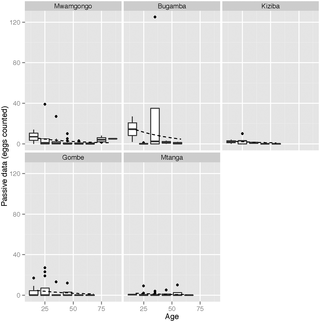PLOS Neglected Tropical Diseases ( IF 3.8 ) Pub Date : 2017-09-21 , DOI: 10.1371/journal.pntd.0005937 Jared S Bakuza 1, 2 , Matthew J Denwood 3, 4 , Gamba Nkwengulila 5 , Barbara K Mable 1

|
Background
Schistosoma mansoni is a parasite of major public health importance in developing countries, where it causes a neglected tropical disease known as intestinal schistosomiasis. However, the distribution of the parasite within many endemic regions is currently unknown, which hinders effective control. The purpose of this study was to characterize the prevalence and intensity of infection of S. mansoni in a remote area of western Tanzania.
Methodology/Principal findings
Stool samples were collected from 192 children and 147 adults residing in Gombe National Park and four nearby villages. Children were actively sampled in local schools, and adults were sampled passively by voluntary presentation at the local health clinics. The two datasets were therefore analysed separately. Faecal worm egg count (FWEC) data were analysed using negative binomial and zero-inflated negative binomial (ZINB) models with explanatory variables of site, sex, and age. The ZINB models indicated that a substantial proportion of the observed zero FWEC reflected a failure to detect eggs in truly infected individuals, meaning that the estimated true prevalence was much higher than the apparent prevalence as calculated based on the simple proportion of non-zero FWEC. For the passively sampled data from adults, the data were consistent with close to 100% true prevalence of infection. Both the prevalence and intensity of infection differed significantly between sites, but there were no significant associations with sex or age.
Conclusions/Significance
Overall, our data suggest a more widespread distribution of S. mansoni in this part of Tanzania than was previously thought. The apparent prevalence estimates substantially under-estimated the true prevalence as determined by the ZINB models, and the two types of sampling strategies also resulted in differing conclusions regarding prevalence of infection. We therefore recommend that future surveillance programmes designed to assess risk factors should use active sampling whenever possible, in order to avoid the self-selection bias associated with passive sampling.



























 京公网安备 11010802027423号
京公网安备 11010802027423号